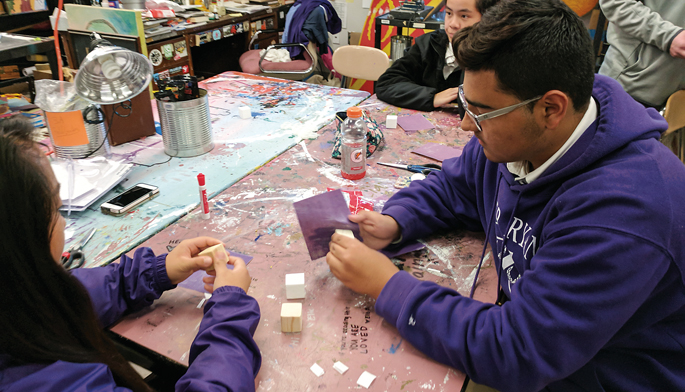
Mike Mitchell, visual arts instructor at Father Ryan High School, and Meg Benningfield, MD, MSCI, division director for Child and Adolescent Psychiatry at Vanderbilt University Medical Center, have been close friends since their children enrolled in the same kindergarten six years ago.
When Mitchell told Benningfield about an art project in which his students were creating cubes of basic symbols designed to help children learn English at a local elementary school, the conversation gave Benningfield the idea to create a cube encompassing the six basic human emotions (happy, sad, angry, surprised, disgusted and afraid) using emojis to incorporate in a pediatric psychiatry setting.
Mitchell volunteered his class to create what the pair called “feelings dice,” which were handed out last year to VUMC’s second-year Psychiatry fellows. The fellows used the dice to engage patients in a conversation about situations that caused them to feel each of the emotions.
“We know that being able to use language to identify feelings is helpful for kids’ ability to manage and deal with their feelings, so the original game we came up with was having them roll the die, and when it landed on an emotion, we would ask them what that emotion feels like in their body and how they’re likely to react when they feel that way,” said Benningfield, associate professor of Psychiatry and Behavioral Sciences and Pediatrics.
But the collaboration didn’t stop there. Benningfield and Kiera Schlansky, MD, resident physician in the Department of Psychiatry and Behavioral Sciences, took the concept a step further by contemplating how it could be used to help patients learn and remember coping techniques.
Using the same concept of emojis glued to a small, wooden block, Schlansky created an activity the department calls “Coping Cubes,” which was launched in the Adolescent Partial Hospitalization Program in December 2018.
Patients pick six emojis from a bank, each representing a coping skill they want to try. A dog emoji could mean taking the family’s dog for a walk or volunteering time at an animal shelter, while a laughing emoji might symbolize watching funny videos or talking with a friend who makes the patient laugh.
“The thing I love about this is that there are no names on the emojis, so it’s open to interpretation,” said Benningfield. “All the patient needs is a reminder of what they decided to practice and why they decided to practice it, so it makes it really flexible and practical.”
Patients keep track of what each symbol means to them by filling out a reference sheet at the time they create the cube. Each cube also comes with a journal sheet to help track when the patient practiced each skill and whether it worked in that situation.
“You come up with coping skills you want to try and take them home with you in a physical representation,” said Schlansky.
Patients can then bring their cubes back to the Adolescent Partial Program the next day after a full night of practice to discuss which coping strategies did and didn’t work in a real-time setting, allowing them to modify their skills bank as they go. By the end of the program, each patient will have six coping skills they have tried, tested, modified and discussed, giving them a better sense of which strategies work best for them.
Clinicians also encourage patients to share their blocks with their families to help articulate how activities like coloring or taking a shower may help them cope with difficult feelings.
The students in Mitchell’s Introduction to Art and 3D Design class at Father Ryan prep the cubes for patients by cutting the wood down to size and sanding and painting the surfaces. For Mitchell, the project provides a way to teach students how to safely use a chop saw while also having their work positively impact other children in the community.
“All of the students who have worked on the project thus far have been really impacted by the idea that these blocks might help someone create a structure for navigating their day-to-day life,” said Mitchell, who added that the project has opened discussions about establishing strategies for managing trauma before trauma occurs.
Mitchell and Benningfield hope that Coping Cubes will not only help patients cope with distress, but also will serve to decrease stigma about mental health needs in adolescence.
According to Mitchell, “It has definitely helped create a more open space to discuss mental health in the classroom, and it hopefully is adding to the existing culture on campus being created by the administration, guidance department, teachers, coaches and students of being known and loved while at Father Ryan High School.”












